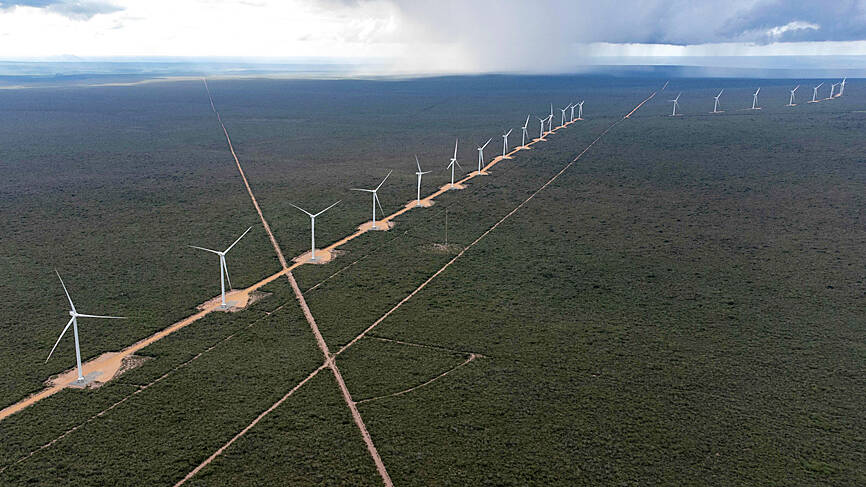For indigenous leader Zenivaldo Bezerra, listening to the “enchanted” — ancestral spirits — required waiting until the dead of night for absolute silence in his rural community in northeastern Brazil.
However, a quiet night has become rare for the Pankararu, a group of about 7,500 indigenous people in Pernambuco state, because of the hum from 52 wind turbines built on the surrounding savannah without their consent.
“You try to connect [with the enchanted], and nine times out of ten, the noise stops you from doing it,” Bezerra said.

Photo: AFP
The Entre Serras Pankararu people, living in 17 villages and led by Bezerra, are one of five indigenous communities in Brazil less than 5km from wind farms, an analysis of government data by the Thomson Reuters Foundation has found.
According to Brazilian federal regulation, indigenous peoples have to be consulted when transmission lines are developed within that distance. In Entre Serras’ case, the closest tower is just 50m away, and the transmission line 180m away.
However, an easing of government regulations over 20 years ago has made it easier for companies to set up wind farms without an official consultation.
Worldwide, governments are embracing renewable energies such as wind and solar power to shift from fossil fuels under the 2015 Paris Agreement to fight climate change.
However, people ranging from smallholder farmers in India to reindeer herders in the Arctic often feel marginalized by clean energy projects on their land. Human rights advocates say local peoples need a far bigger role to secure a just green future.
Last year, Enel, the Italian energy company which runs the Entre Serras wind project, spent 430 million reals (US$88 million) to add 18 turbines to the original 34 operating since 2013, giving an installed capacity of 180 megawatts, enough to power tens of thousands of homes.
Enel says it is working with Funai, Brazil’s indigenous affairs agency, to develop an “Indigenous Basic Environmental Project” for the Pankararu.
Over the years it has made donations to the community, including to fund an annual cultural event.
“They [Enel] are offering compensations,” Bezerra said. “Those, in my opinion, don’t pay for even 10 percent of the damage they caused in our territory and continue to cause to this day.”
He declined to give details of the offer.
Enel said in a statement that all its activities were authorized by Pernambuco’s state environment agency CPRH.
And it said that it reached out to Funai in 2012 to discuss the project — before construction started — but received no response. Neither CPRH nor Funai replied to repeated requests for comment.
In Brazil, wind power firms are benefiting from a change in regulation made during a 2001 energy crisis, when a severe drought reduced water levels in hydroelectric dams the country relied on to generate most of its electricity.
The change allowed energy projects of “low impact,” a category including wind farms, to be approved with a Simplified Environmental Report (RAS), instead of a more complex Environmental Impact Study (EIA/Rima).
The RAS system could cut approval times for new projects down to 30 days from about six months, said Wallason Farias de Souza, an adjunct professor at Ceara State University who researched the issue.
And the RAS dropped a requirement under the former rules to consult indigenous peoples and other local communities before going ahead. It requires merely a “technical information meeting” with those affected.
In 2001, wind power accounted for less than 1 percent of the energy produced in Brazil. Last year, it reached about 8 percent, making wind second only to hydro in Brazil’s power mix, according to the annual report for this year by the Global Wind Energy Council.
Due to the rapid expansion of wind power, some communities only realized a wind farm was being set up when machinery arrived to build it, Souza said.
Since 2001, some states have put curbs on environmental licensing via the fast-track RAS system. In the northeastern state of Ceara, for example, an EIA/Rima is required in cases where a wind farm is planned for a “fragile environment.”
Companies have also got better at consulting and informing communities, Souza said. Even so, he believes “it’s necessary to review” the use of RAS.
Brazilian President Luiz Inacio Lula da Silva has championed both the development of wind power and respect for indigenous rights as ways to preserve the environment and fight climate change.
In Brazil, wind power companies pay an estimated R$165 million a year to landowners to lease land where wind farms are sited, according to a 2020 study from ABEEolica, an association of wind power companies.
The money benefits many small landowners in Brazil’s poor northeast, which generates most of the country’s wind power. According to ABEEolica, the sector creates jobs and boosts the local economy.
The benefits are not always felt by those who live near the wind farms, like the Pankararu, critics say.
Compensation to local communities tends to be low, such as donations to build a park or a daycare center, said Fernando Joaquim Ferreira Maia, who leads a group of researchers exploring the impact of wind farms in Brazil.
“It is not a relevant socio-environmental compensation compared to how [the companies] will profit and the damage they leave behind,” said Maia, a professor at the Federal University of Paraiba state.

PERSISTENT RUMORS: Nvidia’s CEO said the firm is not in talks to sell AI chips to China, but he would welcome a change in US policy barring the activity Nvidia Corp CEO Jensen Huang (黃仁勳) said his company is not in discussions to sell its Blackwell artificial intelligence (AI) chips to Chinese firms, waving off speculation it is trying to engineer a return to the world’s largest semiconductor market. Huang, who arrived in Taiwan yesterday ahead of meetings with longtime partner Taiwan Semiconductor Manufacturing Co (TSMC, 台積電), took the opportunity to clarify recent comments about the US-China AI race. The Nvidia head caused a stir in an interview this week with the Financial Times, in which he was quoted as saying “China will win” the AI race. Huang yesterday said

Nissan Motor Co has agreed to sell its global headquarters in Yokohama for ¥97 billion (US$630 million) to a group sponsored by Taiwanese autoparts maker Minth Group (敏實集團), as the struggling automaker seeks to shore up its financial position. The acquisition is led by a special purchase company managed by KJR Management Ltd, a Japanese real-estate unit of private equity giant KKR & Co, people familiar with the matter said. KJR said it would act as asset manager together with Mizuho Real Estate Management Co. Nissan is undergoing a broad cost-cutting campaign by eliminating jobs and shuttering plants as it grapples

The Chinese government has issued guidance requiring new data center projects that have received any state funds to only use domestically made artificial intelligence (AI) chips, two sources familiar with the matter told Reuters. In recent weeks, Chinese regulatory authorities have ordered such data centers that are less than 30 percent complete to remove all installed foreign chips, or cancel plans to purchase them, while projects in a more advanced stage would be decided on a case-by-case basis, the sources said. The move could represent one of China’s most aggressive steps yet to eliminate foreign technology from its critical infrastructure amid a

MORE WEIGHT: The national weighting was raised in one index while holding steady in two others, while several companies rose or fell in prominence MSCI Inc, a global index provider, has raised Taiwan’s weighting in one of its major indices and left the country’s weighting unchanged in two other indices after a regular index review. In a statement released on Thursday, MSCI said it has upgraded Taiwan’s weighting in the MSCI All-Country World Index by 0.02 percentage points to 2.25 percent, while maintaining the weighting in the MSCI Emerging Markets Index, the most closely watched by foreign institutional investors, at 20.46 percent. Additionally, the index provider has left Taiwan’s weighting in the MSCI All-Country Asia ex-Japan Index unchanged at 23.15 percent. The latest index adjustments are to